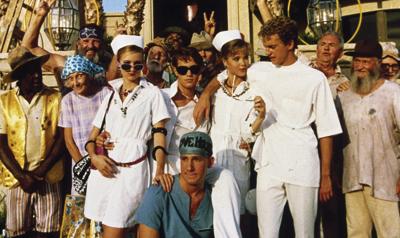It’s easy to trip out on the breadth and legacy of the films Robert Altman made during his time on this earth. Through diligence and a healthy sense of adventure, he dipped toes into and captured images from just about every sort of storytelling one could envision. This is a man who got a film greenlit (1977’s 3 Women) based on a dream he had. So in the insane media landscape of 1983, coming off his stoner musical for children, Popeye, it somehow makes sense that several executives at MGM/UA thought there was a perfect synthesis to be had in noteworthy maverick Altman and a pair of recurrent characters from National Lampoon magazine, O.C. Ogilvie and Mark Stiggs. The end result would sit on studio shelves for four years before the world at large got the chance to see what the fuss was about.
The thing about O.C. and Stiggs that allows it a certain kind of infamy, even among the shunned entries of the Altman canon, is that it wasn’t made out of humane care, or surgical diagnosis, or even a vacation-disguised-as-a-shoot kind of lark. This is a movie made out of finely tended spite.
O.C. and Stiggs is a raucous teen comedy in the midst of the Reagan era, steeped in consumerism, aspirational affluence, casual racism and homophobia, and wild music choices — and yes, that sounds like the recipe for every beloved, problematic John Hughes film we’re still trying to figure out the proper perspective on, and place for, 40 years on. The fact that Hughes got his start at National Lampoon helps make things start to cohere even further; you can even see why a studio would think this could tap into the teen market and yield heaps of dollars. So yeah, why not get Robert Altman on board to make a film about everything he can’t stand about that era’s dominant culture?
O.C. (Daniel Jenkins) and Stiggs (Neill Barry) are like many mammals slowly baked into insanity by the relentless Arizona heat. Their shenanigans are focused on funsies and the ceaseless torment of the Schwab family, whose patriarch (Paul Dooley) runs the insurance agency that has stuck O.C.’s grandfather (Ray Walston) in a nursing home, meaning that at the end of the summer, O.C. will have to leave Phoenix. Pranks, conspiracies, the impersonation of a sovereign head of state and a couple of showstopping musical numbers ensue.
The truth about this film is that it takes a good five or six viewings before you can actually start to enjoy it. The first go-around, everything feels so jarringly unpleasant that you just have to ford onward to try to find some sort of point of ingress with the material. That said, there are enjoyable facets to latch onto on first look — an urban assault vehicle called the Gila Monster, a pleasant Cynthia Nixon turn, a devotion to the music and ethos of musician King Sunny Adé, who also provides the film’s propulsive score — and it is such a distinctive and unexpected vibe that anyone into the idea of cultural anthropology is going to tap into things. But it is an illuminating point that can neither be understated or escaped: What most of us perceive as ’80s nostalgia at this point in time is never something like O.C. and Stiggs, which is one of the reasons why the chance to see a film print of this in a theater is essential.
Like The Osterman Weekend, O.C and Stiggs could be one of the films that got Dennis Hopper off drugs, or back on them. It’s hard to say. Over many years with this film, I have genuinely grown to like whatever the hell kind of spell it’s casting, though it is positively criminal to waste Jane Curtin in such a fashion. Her Elinore Schwab is a cipher of sitcom alcoholism, retrieving hidden liquor in every scene she’s in like someone felt that Mrs. Mac from Black Christmas was too reticent and subtle. But hell, farce is where you find it. Oh, and fans of Altman’s magnum opus Nashville take note: Hal Phillip Walker actually physically appears in this one. And it all feels of a piece with this portrait of bile and juju, Lisa Frank pastels burned into dusky ash by the unyielding heat.
The pantheon of lesser-known/lesser-loved Altman is a wild space to just sort of soak in. 1979’s sci-fi whatsit Quintet is the most infamous one, but there are also films like H.E.A.L.T.H., and A Wedding, and Streamers. And who could forget Dr. T & The Women? These are films that just got sort of put in grandma’s bric-a-brac cabinet because the ’70s masterpieces and the ’90s and Aughts comebacks got the primo location in the collective consciousness. But whether you love it or hate it, there is simply nothing else in any theater as distinctive as this forgotten work of sculpted disdain and the adventure of menace.





